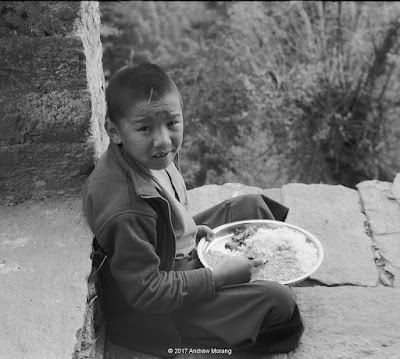One of our projects in the area around the town of Bhachchek was to visit rebuilt schools. Some of the reconstruction was funded by the Gorkha Foundation, which developed innovative school buildings with translucent fiberglass walls. We also visited some schools to donate dental supplies to the children and teachers.
At the elementary school in Bhachchek, the children line up and do some exercises before class starts. The children we saw were well-behaved and cheerful.
We tried to instruct the children about dental hygiene. They were familiar with the concept of tooth brushing, but flossing was a bit too complicated for the little kids. But they were thrilled with their packets of tooth supplies.
While hiking uphill to the village of Siran Danda, we saw children in gray uniforms and neckties. These children go to a private school, not the elementary school in the previous pictures. These students were also fascinated by the odd lumpy Westerners.
The second day, we walked to a construction site in the town of Birauta, where the Gorkha Foundation had built one of their buildings. The village elders fed us a hearty mid-morning snack. Our host was a former UK army officer, Sub. Gobinda Gurung. He had been very organized and effective in 2015 when the earthquake struck, and lobbied the government effectively for relief supplies and other assistance for his townspeople. The children thought we were very odd (well, we are).
 |
| Courtesy of the Gorkha Foundation, April 2018 |
 |
| Telling the students in Nepani about tooth hygiene. The guys responded to a hint that girls like fellows with good clean teeth. |
 |
| Talking to the teachers about kits that let young ladies continue to attend school when they have their periods. This is a Gorkha Foundation building with translucent sides. |
I was impressed by the range of ages. It is a secondary school, but the teachers bring their little ones to work with them. The older students learn English and high school-level material. Mixing all ages reminds me of some Montessori schools, where older students help instruct the younger ones.
The last photograph, of the young laughing ladies, is my favorite frame from the 2017 Nepal trip. I took it with a Leica IIIC rangefinder camera and 5cm ƒ/2.0 Summitar lens on Ilford Delta 100 film, exposed at E.I of 80. The Leica is small and unobtrusive, and the shutter release makes a subtle "click." I think it is much less intimidating than a modern DSLR, which looks like the photographer is pointing a cannon at its victims.








































